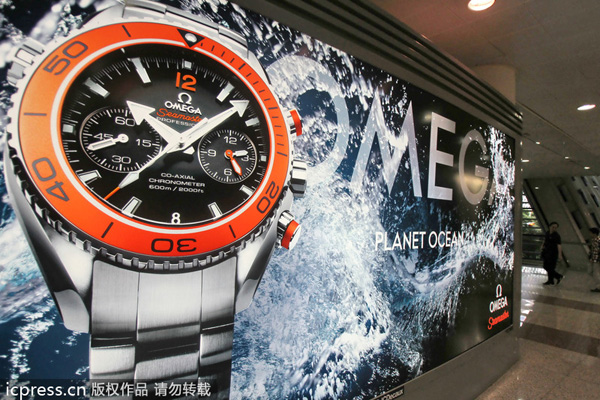 Thu, Jan 9, 2025
Thu, Jan 9, 2025

|
 |
|
A man passes by an Omega billboard in Shanghai Hongqiao International Airport in this file photo taken in 2012. [Photo/icpress.cn] |
"China remains a very important market for us. Last year marked a successful year for Omega in China, where we upheld our leadership position in the market while consolidating our retail strategy. We are confident that this trend will continue as we expand our network of monobrand boutiques."
Urquhart says that like most luxury brands, Omega will continue to exploit the Chinese market by moving into smaller cities where there are considerable business opportunities.
The company has also consolidated its online presence in the country, both with its website and mobile sites, which Urquhart says have become important parts of its marketing.
"Omega has experienced continued success in China. This is something we intend to maintain in the future."
While Swiss watch groups have been grappling with weak demand for upmarket timepieces in China, the sales of their mid-range watches have been growing strongly, especially those priced between 10,000 yuan ($1,639) and 35,000 yuan.
China's General Administration of Customs says that nearly 4 million watches were imported in the first four months of this year, 43 percent more than in the corresponding period last year. But the total sales value of those watches fell significantly, to about $608 million, 22.6 percent less than last year.
Helped by lower prices, Longines, a 180-year-old Swiss watch brand, says it sees no sign of a slowdown in the Chinese mainland even if people are becoming more conservative in their spending.
"Mid-priced brands have continued to sell well in China as people look to more moderately priced luxury brands in a slowing economy," says Li Li, vice-president of Longines China.
Longines draws more than half of its revenue from China. Its sales in the mainland have maintained double-digit growth in recent years.
"Longines watches are priced between 10,000 yuan and 30,000 yuan in China, which is affordable for the Chinese middle class, making it a good choice for those who want to get a time-honored Swiss watch brand at a good price," Li says.
In addition to relatively low prices, Li says, design is also a key to Longines' success in China.
"The Chinese appreciate watches with classic, elegant and timeless styling, unlike sports watches and chronographs, which are more popular with Western customers."
In July, China and Switzerland signed a free trade agreement, the first of its kind between China and a major Western economy.
Under the agreement, tariffs on Swiss watches imported to China will be reduced by 60 percent over 10 years. For many prospective buyers in the mainland, that holds out the hope of falling prices and of buying up-market watches locally instead of overseas, where, at present, luxury watches are much cheaper.
However, while some hail falling tariffs as a stimulus for China's high-end watch market, others doubt that they will have a significant impact on the retail prices of Swiss watches on the mainland.
"The 60 percent tax reduction does not necessarily imply a corresponding reduction in retail price," Li of Longines says, adding that he expects the impact of the tariff cuts on the local market to be limited.
At the moment China imposes an 11 percent import tariff and a 17 percent value-added tax on imported watches, plus an extra 20 percent consumption tax will be imposed on a watch priced above 10,000 yuan, he says. But only the import tariff will be cut. The free trade agreement does not affect the other two.
"The import tariff accounts for the smallest part of the duties on Swiss watches, so the retail price of Swiss watches will not fall significantly in China under the new policy."
Even if that is the case, watchmakers can still benefit from the free trade deal.
"The trade deal will provide a good platform for technological and talent exchanges between Chinese and Swiss watchmakers," says Zhang Hongguang, deputy director of the China Horologe Association.
Although China is the world's largest maker of watches, accounting for 82 percent of world production, China-made movement is not listed in the imported product catalog of Switzerland.
"There is a big gap in quality between watches made in China and those made in Switzerland, but China's watch industry has begun to upgrade," Zhang says.
"The signing of the trade agreement will further protect watch brands' intellectual property rights and require the development of supporting services for upmarket watch businesses in China, such as increasing the number of repair and maintenance shops in the mainland."
 Hot models at SEMA Show
Hot models at SEMA Show
 Modified Scion FR-S (Toyota 86) at SEMA Show
Modified Scion FR-S (Toyota 86) at SEMA Show
 Scion FR-S (Toyota 86) modified by Airaid at SEMA Show
Scion FR-S (Toyota 86) modified by Airaid at SEMA Show
 Models at Spyder pavilion at SEMA Show
Models at Spyder pavilion at SEMA Show
 Models at Anso pavalion at SEMA Show
Models at Anso pavalion at SEMA Show
 Modified Ford Fiesta by 3D Carbon at SEMA Show
Modified Ford Fiesta by 3D Carbon at SEMA Show
 Modified Ford Fiesta ST by MRT at SEMA Show
Modified Ford Fiesta ST by MRT at SEMA Show
 Modified Ford Fiesta ST by COBB at SEMA Show
Modified Ford Fiesta ST by COBB at SEMA Show